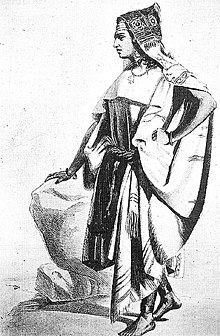 A painting of a Kabyle woman in folk costume | |
| Total population | |
| c. 6 million[1][2] | |
| Regions with significant populations | |
| Kabylia | |
| c. 5 million[3][4][1] | |
| c. 1 million[5][6] | |
| 37,415[7] | |
| Languages | |
| Kabyle Algerian Arabic,[8] French[9] | |
| Religion | |
| Predominantly Islam[10][11] | |
The Kabyle people (/kəˈbaɪl/, Kabyle: Izwawen or Leqbayel or Iqbayliyen, pronounced [iqβæjlijən], Arabic: القبائل, romanized: al-qabā'il)[12][13] are a Berber ethnic group indigenous to Kabylia in the north of Algeria, spread across the Atlas Mountains, 160 kilometres (100 mi) east of Algiers. They represent the largest Berber population of Algeria and the second largest in North Africa.
Many of the Kabyles have emigrated from Algeria, influenced by factors such as the Algerian Civil War,[14] cultural repression by the central Algerian government,[15] and overall industrial decline. Their diaspora has resulted in Kabyle people living in numerous countries. Large populations of Kabyle people settled in France and, to a lesser extent, Canada (mainly Québec) and United States.
The Kabyle people speak Kabyle, a Berber language. Since the Berber Spring of 1980, they have been at the forefront of the fight for the official recognition of Berber languages in Algeria.
- ^ a b Amazigh at Ethnologue (25th ed., 2022)

- ^ Pereltsvaig, Asya (3 September 2020). "6.3 Berber languages". Languages of the World: An Introduction. Cambridge University Press. p. 203. doi:10.1017/9781108783071. ISBN 978-1-108-78307-1.
- ^ Maddy-Weitzman, Bruce (20 September 2018). Rowe, Paul S (ed.). "The Berbers (Amazigh)". Routledge Handbook of Minorities in the Middle East: 314. doi:10.4324/9781315626031-23. ISBN 9781315626031. S2CID 187966078.
- ^ Maddy-Weitzman, Bruce (30 December 2015). "Berbers (Amazigh)". In Smith, Anthony D; Hou, Xiaoshuo; Stone, John; Dennis, Rutledge (eds.). The Wiley Blackwell Encyclopedia of Race, Ethnicity, and Nationalism. Oxford, UK: Wiley. p. 1. doi:10.1002/9781118663202.wberen411. ISBN 978-1-118-66320-2. Retrieved 23 December 2022.
- ^ "Rapport du Comité consultatif pour la promotion des langues régionales et de la pluralité linguistique interne (2013)". www.culture.gouv.fr (in French). Retrieved 25 December 2022.
- ^ Chaker, S. (1 May 2004). "Kabylie : La langue". Encyclopédie berbère (in French) (26): 4055–4066. doi:10.4000/encyclopedieberbere.1431. ISSN 1015-7344.
- ^ "Knowledge of languages by age and gender: Canada, provinces and territories, census divisions and census subdivisions". Census Profile, 2021 Census. Statistics Canada Statistique Canada. 7 May 2021. Retrieved 3 January 2023.
- ^ Frawley, William J. (2003). International Encyclopedia of Linguistics: AAVE – Esperanto, Volume 1. Oxford University Press. p. 221. ISBN 978-0195139778. Retrieved 21 December 2017.
- ^ https://www.britannica.com/topic/Kabyle-people
- ^ https://www.algeria.com/blog/insight-into-the-kabyle-people-of-algeria/
- ^ https://minorityrights.org/communities/amazigh/
- ^ "Centre de Recherche Berbère – Ecriture: Libyque & tifinagh". www.centrederechercheberbere.fr. Retrieved 18 April 2021.
- ^ Lanfry, Jacques (1978). "Les Zwawa (Igawawen) d'Algérie centrale (essai onomastique et ethnographique)". Revue des mondes musulmans et de la Méditerranée. 26 (1): 75–101. doi:10.3406/remmm.1978.1825.
- ^ "The Kabyle Berbers, AQIM and the search for peace in Algeria | Algeria | al Jazeera".
- ^ Amazigh-state relations in Morocco and Algeria Archived 2020-03-23 at the Wayback Machine